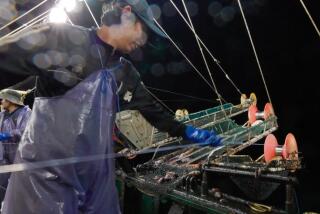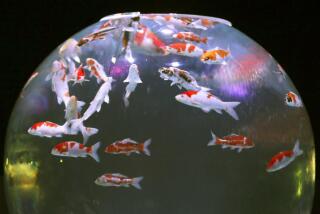Japan, Taiwan Assailed on ‘Destructive’ Fishing : 15 Nations Seek Ban on Drift Nets
- Share via
TARAWA, Kiribati — Momentum is building for a global ban on the controversial practice of drift-net fishing.
Fifteen South Pacific nations have launched a stinging verbal and diplomatic attack on Japan and Taiwan for “indiscriminate, irresponsible, and destructive” drift-net fishing.
The “Tarawa Declaration,” produced earlier this month at the 20th South Pacific Forum in Kiribati, calls for a drift-net-free zone in this region followed by a concerted push for a worldwide ban.
It also praises Korea for recently vowing to stop its fishing boats from using drift-nets.
Similar to the Assn. of South-East Asian Nations (ASEAN), the forum is the major political organization in the region.
Drift-net fishing dominated discussions at this year’s annual gathering of South Pacific leaders.
Drift, or “gill,” net fishing involves laying strings of nets 30-feet deep and 20 to 30 miles long. The massive nets are left to drift overnight and then retrieved. About 1,000 Japanese and Taiwanese fishing boats use the nets, ostensibly, to catch squid in the North Pacific. A fleet of 190 (two-thirds from Taiwan) came to the South Pacific last season to catch tuna.
But the small-mesh nylon nets snare, and often kill, almost all marine life--dolphins, sea birds, whales and turtles. Environmentalists dub them “walls of death.”
In June, under the threat of U.S. trade sanctions, Japan and Taiwan agreed separately to increased monitoring and enforcement of restrictions on drift-net fishing in the North Pacific.
The Taiwan agreement--which was reached a few days after the U.S. Coast Guard went on a three-day, 600-mile chase after a Taiwanese boat--is the tougher of the two. It requires transmitters on 10% of the boats this year so they can be tracked by satellite, with 100% coverage by next year. It also allows U.S. officials to board vessels suspected of violating the agreement.
For several years, Canadian and U.S. fishermen in coastal waters have pushed for a drift-net ban. They say Asian boats are reducing the salmon catch in territorial waters by overfishing the migratory juvenile fish in international waters.
Similarly, South Pacific countries claim, the drift-net boats took two to three times the sustainable yield of young albacore tuna last year from a major fishing ground east of New Zealand.
If this catch rate continues, Forum fishery scientists said, a stock vital to tiny island-nation economies could be destroyed in two years.
“It’s obviously unacceptable that you can have a practice which . . . if continued will wipe out the resource,” said Australia’s Prime Minister Bob Hawke, who initiated the ban.
On such a sensitive domestic issue as fishing, Japan said it cannot move without more research. “To take a drastic measure like total banning of existing fishing operations we need very concrete data,” said Kiyoshi Araki, director of the Oceania Division in the Ministry of Foreign Affairs.
How long will it take to gather the data? “Maybe one or two years,” Araki said. He also admitted the tuna caught is primarily for export, not to meet domestic needs.
As a Tongan official wryly commented recently, by the time Japan finishes its research, the fish will be gone.
More to Read
Sign up for Essential California
The most important California stories and recommendations in your inbox every morning.
You may occasionally receive promotional content from the Los Angeles Times.













